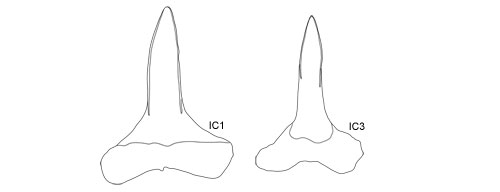| I have been re-examining the fossil teeth of carcharhinids from the Oligocene Yamaga formation, Ashiya group in Kitakyusyu city. The fossil teeth from this formation are relatively well-preserved, but they often bear cracks caused by crustal movements such as earthquakes. The fossil containing matrix is very solid, therefore isolating the root in the teeth without distinctive damages is almost not possible, and the fossil with the damaged root makes it difficult to identify with accuracy. This time, I examined a total of 306 samples. As a result, 172 teeth (54.9%) among them were assigned to carcharhinids. The most abundant species among them were Isogomphodon (18.3%), Negaprion (17.0%), and an unidentified species (15.4%). The unidentified species is very close to Isogomphodon in its form, but its cutting-edge is incomplete while Isogomphodon bears complete cutting-edges. The teeth of Negaprion have very weak serrations in the heals, and were assigned to N. acutidens rather than N. brebirostris. |
1. Isogomphodon sp.
| Isogomphodon: 18.3% of Ashiya samples: narrow smooth crown, cutting edge complete. |

2. Negaprion cfr. acutidens
| Negaprion cfr. acutidens: 17.0% of Ashiya samples: cutting edge complete. |

3. Gen et sp indet.
| gen. et sp. indet: 15.4% of Ashiya samples: slender cusp, incomplete cutting edge. |

cutting-edges in specimens

Percentages of the carcharhinids in the assemblage
| Species % | |||
| 1 | Isogomphodon sp. | 18.3 | |
| 2 | Negaprion cfr. acutidens | 17.0 | |
| 3 | Gen. et sp. indet. | 15.4 | |
| 4 | Carcharias acutissima | 11.8 | |
| 5 | Hexanchus griseus/nakamurai | 7.9 | |
| 6 | Heterodontus sp. Ashiya type | 6.9 | |
| 7 | Squatina sp. | 6.2 | |
| 8 | Squalus sp. | 4.6 | |
| 9 | Carcharhinus spp. | 3.9 | |
| 10 | Hemipristis serra /curvatus | 1.3 | |
| 11 | Isurus sp. (I. praecursor) | 2.3 | |
| 12 | Isurus hastalis | 1.3 | |
| 13 | Alopias latidens | 1 | |
| 14 | Triakid / Hemigaleid | < 1 | |
| 15 | Sphyrna sp. | < 1 | |
| 16 | Galeocerdo sp. | < 1 | |
| Carcharhinidae | |||
Back & Forth
20110112